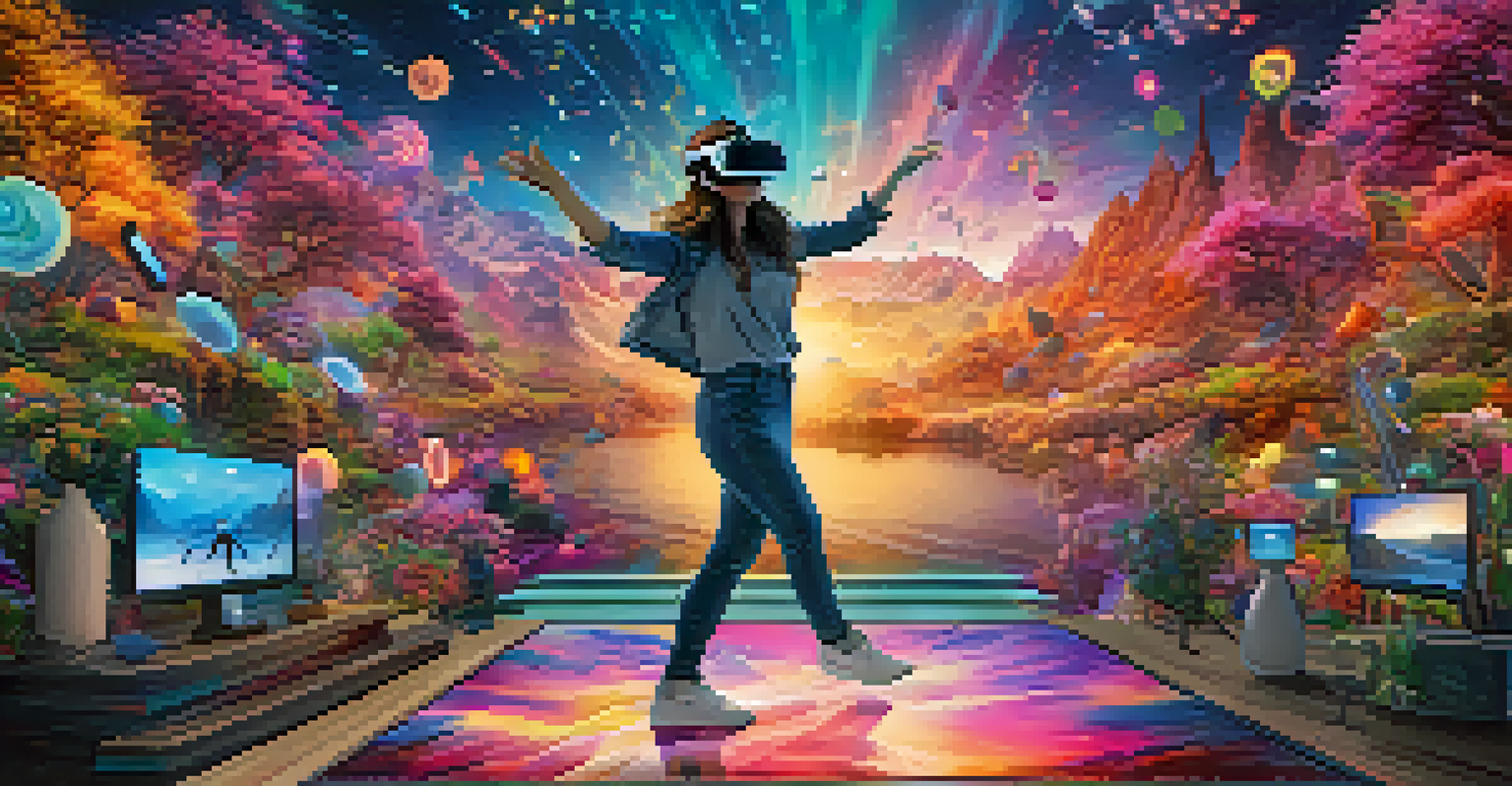The Aesthetics of Dance in Multimedia Storytelling

Understanding Dance as a Narrative Tool
Dance has long been a powerful form of storytelling, transcending language barriers. Through movement, dancers convey emotions and narratives, creating a visceral connection with audiences. In multimedia storytelling, this art form can enhance the narrative by adding depth and layers that dialogue alone cannot express.
Dance is the hidden language of the soul.
For instance, think of a scene in a film where a character experiences heartbreak. Instead of relying solely on dialogue, a choreographed dance can visually embody that pain, allowing viewers to feel it in their bones. This fusion of dance and multimedia creates a richer storytelling experience, engaging audiences on multiple sensory levels.
Ultimately, the integration of dance invites viewers to interpret the story through movement, making it a unique narrative device that resonates deeply with human emotions.
The Role of Choreography in Visual Storytelling
Choreography serves as the backbone of dance in multimedia storytelling, dictating how movements convey meaning. Well-crafted choreography can symbolize various themes, from love and conflict to freedom and confinement. By using space and body language creatively, choreographers can guide the audience's emotional journey through the story.

Take, for example, a dance sequence in a musical film. Each movement can reflect the character's internal struggles and relationships, allowing the audience to understand their motivations without a single word. This visual representation can often be more impactful than traditional dialogue, drawing the viewer into the emotional core of the narrative.
Dance Enhances Narrative Depth
Through movement, dance conveys emotions and stories, enriching multimedia experiences beyond dialogue.
Therefore, effective choreography is not just about aesthetics; it's about enhancing the storytelling and ensuring every movement serves a purpose in advancing the plot.
Dance Integration in Film and Television
Film and television have embraced dance as a vital storytelling tool, often using it to amplify emotional moments. Iconic scenes, like the dance in 'La La Land,' showcase how movement can elevate a narrative, creating memorable, visually stunning moments. These sequences often become defining aspects of the films, leaving lasting impressions on audiences.
The dance is a poem of which each movement is a word.
Moreover, dance allows filmmakers to express complex ideas and emotions succinctly. A well-executed dance scene can convey themes of joy, sorrow, or tension without the need for lengthy exposition. This economy of storytelling is particularly valuable in visual media, where pacing and timing are crucial.
As technology advances, the fusion of dance with cinematic techniques continues to evolve, pushing the boundaries of how stories are told and experienced.
The Impact of Dance in Video Games
In the realm of video games, dance has started to play a pivotal role in storytelling. Game developers are increasingly incorporating dance sequences not just for entertainment, but as a means of narrative progression. These moments allow players to engage with the story in a dynamic way, often reflecting character growth or significant plot developments.
For instance, games like 'Just Dance' and 'Dance Dance Revolution' turn movement into gameplay, making the act of dancing part of the narrative experience. The player's participation transforms the story, creating a sense of agency and immersion that traditional storytelling cannot achieve.
Choreography Drives Emotional Journeys
Well-crafted choreography symbolizes themes and guides audience emotions, making visual storytelling more impactful.
As the gaming industry continues to innovate, we can expect dance to become an even more integral element in how stories are told, allowing players to connect with narratives on a physical and emotional level.
Dance and Interactive Media Experiences
Interactive media, such as virtual reality (VR) and augmented reality (AR), are exploring dance as a means of storytelling in groundbreaking ways. In these immersive environments, users can engage with dance not just as spectators but as active participants. This interactivity creates a unique narrative experience where the viewer's choices can influence the outcome of the story.
Imagine stepping into a VR world where your movements dictate the flow of a dance narrative. This level of engagement allows for a personal connection to the story, making it feel more relevant and impactful. The physicality of dance in these formats can evoke emotions that static visuals cannot achieve.
As technology develops, the potential for dance in interactive storytelling will likely expand, offering even more innovative ways to engage audiences.
The Emotional Resonance of Dance in Storytelling
One of the most compelling aspects of dance in storytelling is its ability to evoke emotion. Through movement, dancers can express feelings that words often fail to capture. This emotional resonance is crucial in building connections between characters and audiences, making the narrative more relatable and profound.
For example, the graceful movements of ballet can evoke feelings of beauty and longing, while the intensity of contemporary dance might convey struggle and conflict. This ability to communicate complex emotions through physicality allows dance to transcend cultural and linguistic barriers, making it a universal form of expression.
Future Trends in Dance Storytelling
Technological advancements are expanding the role of dance in multimedia storytelling, creating immersive and diverse narratives.
Ultimately, the emotional impact of dance enriches the storytelling experience, allowing audiences to connect with the narrative on a deeper level.
Future Trends: Dance in Multimedia Storytelling
As we look to the future, the integration of dance in multimedia storytelling is set to expand even further. With technological advancements like motion capture and AI, the possibilities for creating dynamic dance narratives are virtually limitless. These innovations may allow for the blending of live performances with digital storytelling, creating hybrid experiences that captivate audiences.
Moreover, as diverse voices and styles of dance gain recognition, stories told through movement will become increasingly rich and varied. This diversity not only enhances the narrative landscape but also fosters greater inclusivity within storytelling, resonating with a broader audience.

In conclusion, the future of dance in multimedia storytelling promises to be exciting and transformative, as artists continue to explore new ways to connect with audiences through the power of movement.